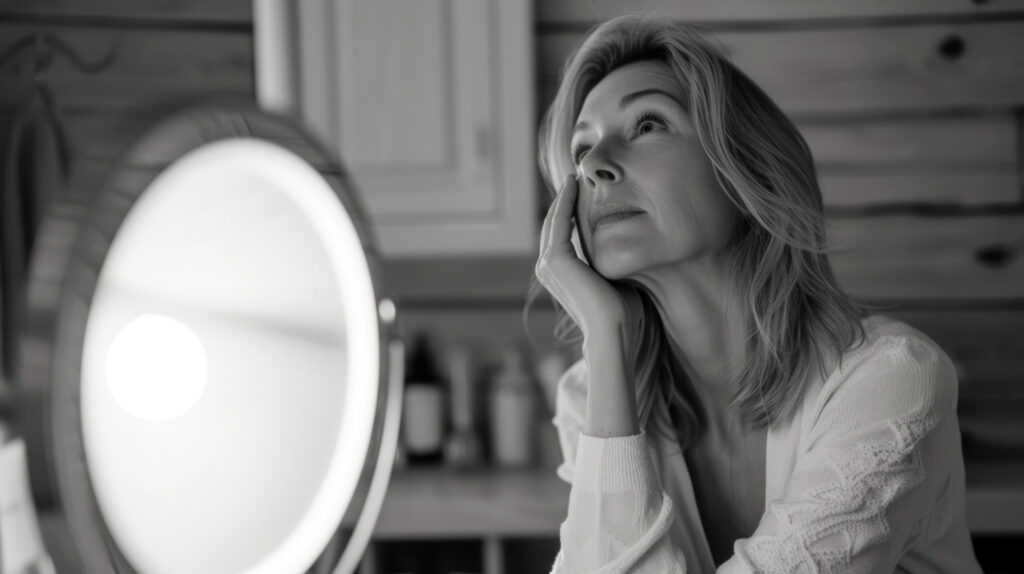That moment when you catch your reflection and think, “When did that happen?” We’ve all been there.
Last week, my friend texted me a photo from her college reunion with the caption: “I look like everyone’s mom now!” We laughed about it, but her message sparked something deeper. At 34, she’s been noticing changes in her face that make her wonder if she’s aging “normally” or if something’s off.
Here’s the thing: turning 30 isn’t like flipping a switch where your face suddenly transforms overnight. But there are some predictable shifts that happen gradually, and knowing what’s typical can help you feel more confident about the changes you’re seeing in the mirror.
The Science-y Stuff (Without the Jargon)
Your face is basically a complex layered cake, and after 30, each layer starts changing at its own pace. Think of it like this: your skin, muscles, fat pads, and bone structure all play different roles in how your face looks and feels.
The most noticeable changes usually start with your skin’s texture and elasticity. You know that bouncy feeling your skin had in your twenties? That’s largely thanks to collagen and elastin production, which naturally starts declining around age 25 and continues dropping by about 1% each year after 30.
But here’s what’s interesting: genetics play a huge role in how these changes show up. Some women notice fine lines around their eyes first, while others see changes in their jawline or cheek fullness. There’s no universal timeline, despite what beauty magazines might suggest.
What’s Completely Normal After 30
Fine Lines Around Your Eyes
Those little crinkles that appear when you smile? Totally normal. Your eye area has the thinnest skin on your face, and it’s constantly moving. Plus, if you’re someone who’s spent time in the sun (hello, poolside summers of our twenties!), this area often shows the first signs of that accumulated exposure.
Changing Skin Texture
Your skin might feel different than it did five years ago – perhaps less smooth or with occasional rough patches. This happens because cell turnover naturally slows down as we age. What used to happen every 28 days in our twenties might now take 35-40 days.
Subtle Volume Changes
You might notice your cheeks don’t look quite as full, or your jawline isn’t as defined as it once was. This is partly due to the gradual loss of facial fat pads and subtle bone changes. It’s like your face is slowly rearranging itself – not necessarily better or worse, just different.
Pigmentation Variations
Those little dark spots or areas of uneven skin tone? If you’ve spent any time in the sun without protection, these are essentially your skin’s way of documenting that history. They’re incredibly common and completely normal.
Changes in Skin Sensitivity
Many women notice their skin becomes more sensitive or reactive after 30. Products that never bothered you before might suddenly cause irritation. Your skin’s barrier function changes over time, making it more susceptible to environmental factors.
What Might Be Worth Noting
While most facial changes after 30 are completely normal, there are a few things that might warrant a conversation with a healthcare professional:
Sudden or Dramatic Changes
If you notice significant changes that happen quickly (over weeks rather than months or years), it’s worth discussing with a professional. Rapid changes can sometimes indicate other factors at play.
New Growths or Moles
Any new spots, moles, or growths that appear, change color, or have irregular borders should be checked. This is just basic skin health awareness, not cause for panic.
Persistent Skin Issues
If you develop ongoing skin problems that don’t respond to gentle care or seem to worsen over time, a dermatologist can help identify what’s going on.
Asymmetrical Changes
While some asymmetry is normal (most faces aren’t perfectly symmetrical), sudden or pronounced asymmetrical changes might be worth discussing with a healthcare provider.
The Lifestyle Factors That Make a Real Difference
Here’s where it gets interesting: how your face ages isn’t just about genetics and time. Your daily habits play a surprisingly big role in how these changes show up.
Sleep Quality Matters More Than You Think
Those “beauty sleep” jokes aren’t actually jokes. Poor sleep quality affects your skin’s ability to repair itself, and chronic sleep deprivation can accelerate visible aging. Plus, we’ve all seen how we look after a terrible night’s sleep – imagine that effect accumulating over time.
Stress Shows Up on Your Face
Chronic stress affects your skin in multiple ways. It can trigger inflammation, affect hormone levels, and even change your facial expressions. Ever notice how people who are constantly stressed tend to develop deeper frown lines or tension around their jaw?
Sun Exposure History
This is probably the biggest lifestyle factor. If you spent your twenties tanning or being casual about sun protection, your face is likely showing some evidence of that now. The good news is that it’s never too late to start protecting your skin from further damage.
Hydration and Nutrition
Your skin reflects your overall health. Chronic dehydration, poor nutrition, or excessive alcohol consumption can all show up in your skin’s appearance and texture.
Facial Expressions and Habits
Do you squint a lot? Purse your lips when concentrating? Sleep on one side consistently? These repeated movements and pressures can contribute to where and how lines develop.
The Emotional Side of Facial Changes
Let’s be honest: seeing your face change can be emotionally challenging, especially in a culture that’s obsessed with looking young. It’s normal to feel a mix of emotions about aging, from acceptance to frustration to curiosity about what’s coming next.
Many women describe feeling disconnected from their reflection for a while as they adjust to their changing appearance. This is completely normal and often temporary. It’s like getting used to a new haircut, but on a longer timeline.
Some find it helpful to reframe aging as a reflection of their experiences and wisdom rather than just physical change. That laugh line around your eyes? It represents thousands of genuine smiles and moments of joy. The character in your face tells the story of your life.
Practical Ways to Support Your Skin Health
While we can’t stop the aging process (and honestly, would we want to?), there are gentle, evidence-based ways to support your skin health:
Gentle Daily Care
A simple routine with gentle cleansing, moisturizing, and sun protection can make a real difference over time. The key is consistency rather than complexity.
Sun Protection as a Daily Habit
This is probably the single most effective thing you can do for your facial skin health going forward. UV protection helps prevent further damage and gives your skin a chance to repair what it can.
Stay Hydrated
Proper hydration supports your skin’s function and appearance. It won’t erase existing changes, but it helps your skin look and feel its best.
Quality Sleep
Prioritizing good sleep hygiene supports your skin’s natural repair processes and can help you feel more confident overall.
Manage Stress
Finding healthy ways to manage stress benefits your entire body, including your skin. This might mean meditation, exercise, therapy, or whatever works for you.
Gentle Movement
Regular physical activity improves circulation, which can contribute to healthy-looking skin. Plus, it’s great for your overall well-being.
When to Seek Professional Input
If you’re concerned about changes in your skin or want personalized advice about skincare, consider consulting with:
- A dermatologist for skin health concerns or questions about skincare routines
- An esthetician for professional skincare treatments and product recommendations
- Your primary healthcare provider if you have questions about how other health factors might be affecting your skin
Remember, these professionals can provide personalized advice based on your specific situation, which is always more valuable than generic recommendations.
The Bigger Picture
Your face after 30 is still your face – it’s just evolving. Some changes are completely normal parts of the aging process, while others might be influenced by lifestyle factors or warrant professional attention.
The most important thing is to approach these changes with curiosity rather than judgment. Your face is documenting your life story, and that includes all the laughter, sun-soaked vacations, late nights with friends, and moments of deep concentration that got you to where you are now.
Instead of fighting against every change, consider which ones you want to embrace and which ones you might want to address through healthy lifestyle choices or professional guidance. There’s no right or wrong way to age, and there’s certainly no timeline you need to follow.
Your face at 30-plus is the face of someone who’s lived, learned, and experienced things. That’s not just normal – it’s beautiful.
Moving Forward with Confidence
The key to feeling good about your changing face is information, self-compassion, and realistic expectations. Most of what you’re noticing is completely normal, and understanding the why behind these changes can help you feel more confident and less anxious about the process.
Remember that everyone’s aging journey is different. Social media and magazines show us heavily edited, filtered, or professionally enhanced images that don’t represent reality. Your real, unfiltered face – with all its changes and character – is perfectly normal and nothing to apologize for.
Take care of your skin, protect it from further damage, and celebrate the face that’s carried you through all your experiences. After all, it’s the only one you’ve got, and it’s telling your unique story.

Disclaimer: Thanks for reading — from all of us at First News US. This article is for informational and lifestyle purposes only and is not intended as professional medical, dermatological, or healthcare advice. The information provided should not be used for diagnosing or treating any health condition. Individual experiences with aging and skin changes vary significantly. For personalized advice about skin health, skincare routines, or any concerns about changes in your appearance, please consult with qualified healthcare professionals such as dermatologists or your primary care provider. Always seek professional medical advice before making significant changes to your skincare routine or if you notice sudden or concerning changes in your skin or appearance.
Sources and References: Information in this article is based on general knowledge about skin aging processes, dermatological research, and common experiences reported in lifestyle and health publications. Specific medical claims have been avoided in favor of general lifestyle information. For current scientific research on skin aging, readers are encouraged to consult peer-reviewed dermatological journals and speak with qualified healthcare professionals.



